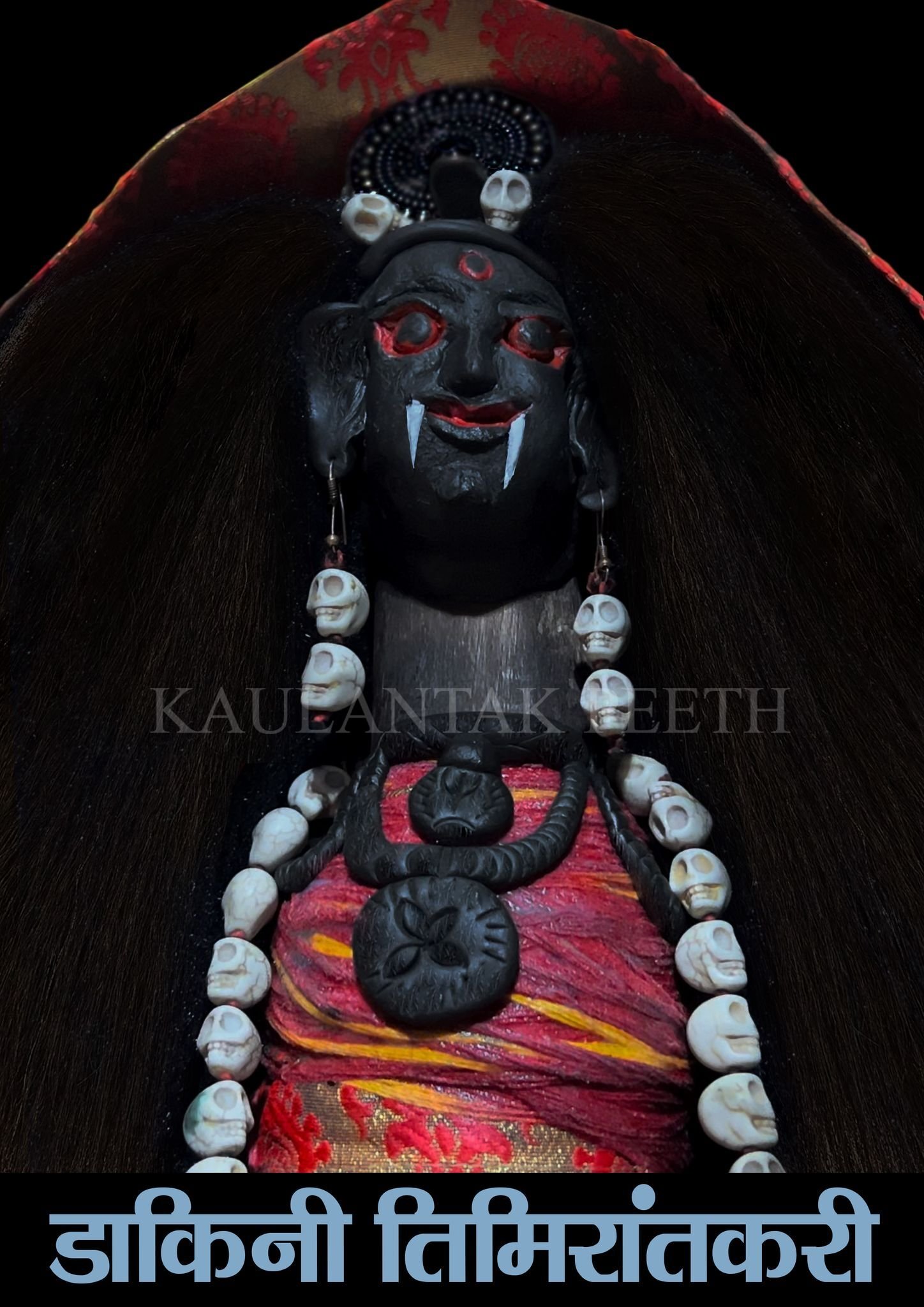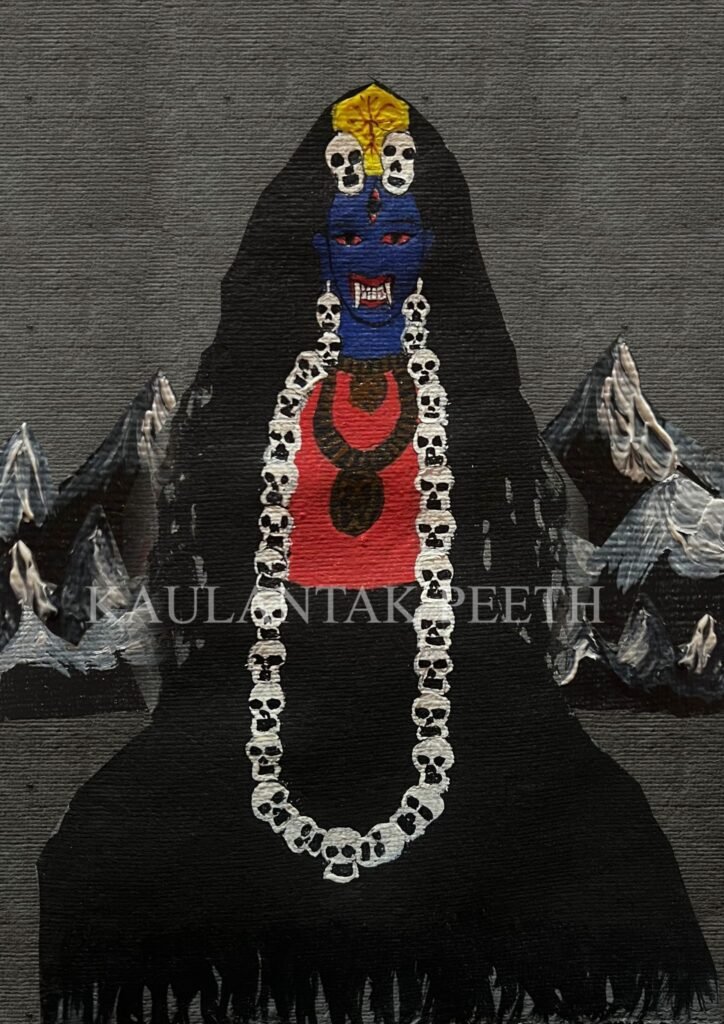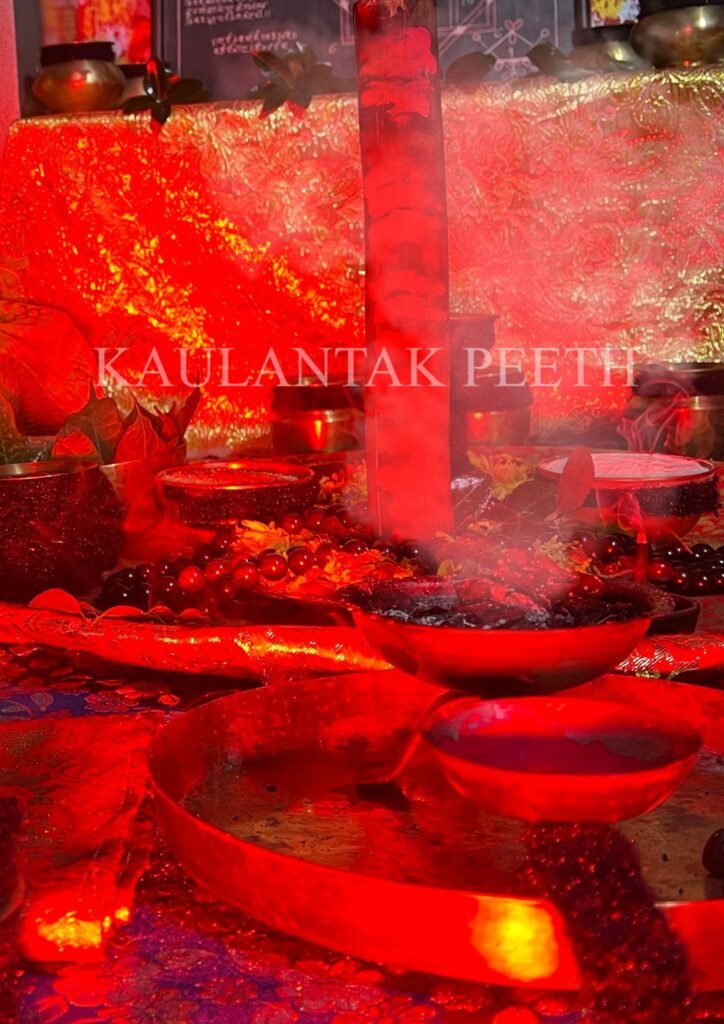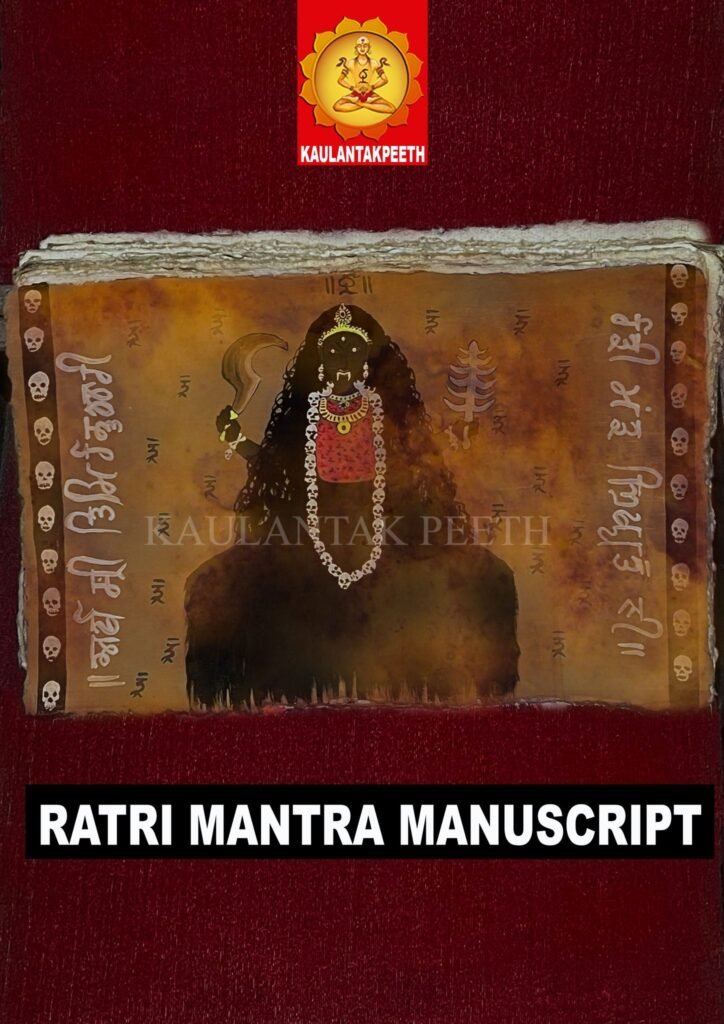The name ‘Timirantakari Dakini’ (Sanskrit: तिमिरान्तकरी डाकिनी ), also known as ‘Devi Timiri’ originates from Sanskrit word ‘Timiri’ (तिमिरी) meaning darkness and ‘Antakari’ (अंतकरी) is the one who ends, which means ‘Timirantakari Dakini’ is the Goddess who ends the darkness.
In Kula Language, She is known as ‘Nihari Dankani’ (Sanskrit:न्ह्यारी डन्कणी ). ‘Timirantakari Dakini’ is known to be the wish fulfilling, protector Goddess with immense magical powers. She has been one of the topmost yet lost Goddess of Himalayan Shamanism and Occult. The Shamans of ‘Timirantakari Dakini’ have always kept Her worship rituals secret from the general public. Therefore, the Dakini Devi Timirantakari Dakini have always been shrouded in mystery.
The unique thing about ‘Timirantakari Dakini’ is that Her representative idol is created only by Her Shamans using a small log of wood covered with animal (Yak) hair. Her face is created using clay or different metals. She wears jewellery made up of skull ornaments which are made from mud or metal. Her worship is done after Sunset.
‘Timirantakari Dakini’ is known as one of the most powerful Goddesses who fights the demons, daityas and other dark powers that awaken in the night. She is known to protect the family, cattle, the house, the fields of Her worshipper. The specialty of Dakini Devi is that She heals physical and mental illnesses and disorders. She helps to raise the spiritual and material prowess of Her worshipper.
Origin
In the pre Agama-Nigam period, when the science of Tantra was in its nascent stage, people worshipped different kinds of Divine powers than the Ones that are worshipped today. Life was difficult in the Western Himalayan areas during those days. One should know that till today, every aspect of life of people living in Himalayan villages of ‘Deva Bhumi’ (the land of Gods) revolve around the Devi-Devatas. It is the experience of the Himalayan people that their ‘Kula Devi-Devatas’ (family Deities) protect their families and cattle from evil forces. Their family deities also guide them in every aspect of their lives.
In the Pre Agama-Nigama period, even the Himalayan people didn’t know about most Devi-Devatas that are prevalent today. They worshipped certain higher powers. Every family had their own private Deity who would protect them against the threats they faced in life. The large families were powerful and dominated the smaller families. The law of ‘Jeeva Jeevasya Bhojanam’ (a saying in Sanskrit) prevailed even then. It means that one life feeds on the life of others on this planet. One man’s suffering is another man’s gain. Humans knew this since they existed on this planet. So the people in the Himalayan areas did everything to dominate one another.
‘Timirantakari Dakini’ is one of the primary Deities who was worshipped in the pre Agama-Nigama times. The story of Her revelation is as interesting as the Dakini Goddess Herself is. Once it happened that the elders of a village in the Western Himalayas discovered that the Himalayan foxes in their area come together on a particular day on ‘Chulik Mountain’ and howl together with their heads raised towards the sky. This happened on the night of ‘Amavasya’ every month. They would collect in thousands of numbers together on that mountain and would raise their heads and howl. The scene seemed unnatural to the elders of the village. It was unnatural in every sense. The word spread in the village and all the elders (men) came together and discussed the unnatural happening that was witnessed.
The elders were scared as this unnatural event rang the bells of potential danger for them and the village. One day the elders decided to go to the mountain peak and see what went on with all the Himalayan foxes present on the mountain. The night of ‘Amavasya’ came and they all waited after the sunset near the ‘Chulik’ mountain. When the foxes came together in thousands of numbers that night, the elder men of the village went to the ‘Chulik’ mountain and waited. In the hour after midnight, the foxes began to behave in a certain manner, came close together and began to howl, raising their heads up to the sky. The men standing there, went right into the middle of their gathering and at that same moment ‘Timirantakari Dakini’ revealed Herself in the sky to all those present there. She appeared from a thunderbolt from the sky. It was the night of ‘Amavasya’ of the ‘Falgun Maas’ (month between the February- March in the Gregorian Calendar).
The villagers expressed that they felt scared to see all the foxes gathering together and then hear them howl in that unnatural manner. The ‘Timirantakari Dakini’ reassured that the foxes won’t behave like this anymore since She has now given ‘Darshan’ (revealed Her manifested form) to all those present there. She blessed them all. From then on, the foxes never did the same as they did for the Dakini Devi before.
Since that time, it is considered inauspicious to kill the foxes. While if the foxes howled in strange voices it is considered as a bad omen. The Dakini Goddess said to the village elders that She would reveal the ways to worship Her later through Her Shaman. Then She disappeared.
Iconography
According to Siddha Dharm, the ’Timirantakari Dakini’ was one of the strangest Divine powers that the villagers witnessed during the pre Agama-Nigama period. She is colossal in Her form. Her dark black hair are so long and dense that Her feet are not seen and Her hair touches the Earth. One could see Her long hair everywhere around her. Her eyes are terrifyingly Red. Yet She is beautiful. The Himalayan foxes looked at Her in the sky and began howling looking at the Dakini Goddess. Such beauty is ‘Timirantakari Dakini’. Her form is wrathful because She has to fight the extreme demonic powers. Although She is a Devi and motherly from Her heart.
‘Timirantakari Dakini’ was depicted in different forms in different regions. Sometimes She is depicted sitting on the black Himalayan owl. At some places Her vehicle is shown as the Black cat while sometimes She sits on the ‘Asan’ of Black Lotus. While at some places She is shown sitting on Her ‘Daka’ (Male Consort) who is known as ‘Ulluka Daka’. In Kula Language, Her ‘Daka’ (male consort of Dakini) is known as the ‘Ujudu Dankan’.
Worship
When the ‘Timirantakari Dakini’ revealed Herself the very first time to the villagers on the night of ‘Amavasya’, one of the old men amongst the elderly of the village asked Her about who She was. The Dakini Goddess revealed that She is a Goddess and if they worshipped Her, She would protect them. She said that the dark night belonged to Her. She originates from the darkness and dissolves into the darkness. She would protect them all from darkness. The elders present there took a long sigh of relief to hear this. They asked how they should worship Her. She asked those men to return to their village and invoke Her in the hair of Yak. She asked to keep some of Yak’s hair aside and then invoke Her there. She further asked to offer Her smoke of Himalayan herbs and to leave their hair (asked them not to cut their hair) as a way to respect the Devi.
It all appeared strange to the villagers. When they returned to the village miracles began to happen in the village. An adolescent boy woke up in the middle of one of those nights and began acting strange. He stopped talking with everyone and remained separate from the crowd almost for a month. Then the boy found the hair of Yak, cut them and pasted them on the small log of wood taken from the ‘Khanor’ (Horse Chestnut) tree found in Himalayas. Then the boy sat near that representative symbol of the ‘Timirantakari Dakini’ that he created. As soon as he sat near the ‘Timirantakari Dakini’s’ representative idol, he connected to the Dakini Goddess and began behaving like a Shaman in ‘Bhav Samadhi’ ( a state of trance when Shamans connect to the Divine energy).
Through this boy, the Devi began to communicate with the villagers. The foremost worshippers in that society hid the Devi’s form of worship from the public and created a secret cult around the ‘Timirantakari Dakini’. It is said that the Dakini Devi Herself communicated on how to worship Her.
Since that time, all the Tantra ritual practices began around the ‘Timirantakari Dakini’. People began to worship Her to gain power and dominance. Her worship gained prominence throughout the Western Himalayan region. Later when the Devatas came to the Himalayas during the period of ‘Agama Nigama’, people began to worship the Devatas. The worship of ‘Timirantakari Dakini’ became an utterly secret affair. While People began to ask the Devatas to fulfil demands in their life and slowly the ‘Timirantakari Dakini’ was forgotten. Only a handful of Tantra practitioners retained Her worship rituals. They hid Her rituals completely from the public and practised Her rituals to earn their living.
People worshipped the Dakini Goddess with different ‘Balis’ (offerings) including animal sacrificial offerings and alcohol. She is worshipped with ‘Satvik’ offerings also. ‘Timirantakari Dakini’ offered the protection of the family and cattle from all demonic forces of darkness and other dark forces. Childless women prayed Her to bless them with children. She majorly protected people from pandemic diseases. She bestowed Her worshippers with different ‘Siddhis’ (skills). If people faced issues with abundance in family, they would ask the Goddess to remove the obstacles in their path to material wealth. But only the designated people had the authority to worship her. The villagers would come to these ‘Tantrik’ and ‘Tantrikas’ (people who had authority to worship the Devi) to offer worship on their behalf.
Bhairava of ‘Timirantakari Dakini’
The Bhairav of Timirantakari Dakini’ called as the ‘Ulluku Daka’ resided on land and water. So Her Bhairav would go through the land and water from one place to another. While She went through ‘Akash Marg’ (through sky). Her Bhairav protected the ones who worshipped the Dakini Goddess.
Women Worshipper of ‘Timirantakari Dakini’
It was mainly women who worshipped the ‘Timirantakari Dakini’. Amongst women, some elderly women had ‘Siddhi’ mastery over the ‘Kula mantras’ of ‘Timirantakari Dakini’. It is said that the Dakini Goddess told the elderly women worshippers that She would bestow them with ‘Siddhis’ if they promised Her that each one of them would pass on Her knowledge and ‘Vidya’ to the next generation. Each woman worshipper had to pass on the knowledge of the Dakini Goddess and of Her worship rituals to at least one woman initiate. The secret cult of ‘Timirantakari Dakini’ was dominated by women.
Relation to Goddess KaalRatri
According to SiddhaDharma, ‘Timirantakari Dakini’ originated from the hair of Goddess Kaal-Ratri. Devi KaalRatri is the seventh form of the Goddess Durga. Goddess Durga has nine forms. Therefore the idol of ‘Timirantakari Dakini’ is covered with hair. Her dress is also depicted as hair. While the complexion of the Dakini Goddess is depicted in Black or Blue or Red.
On the seventh day of ‘Navratri’, when it is the day of Goddess Kaalratri, after the sunset, it is considered the best time for the ‘Siddhi’ of ‘Timirantakari Dakini’. Normally the hands of the Dakini Goddess are not depicted in Her idols. But at some places, She is seen holding the ‘Khadak’ and ‘Vajra’.
Like Goddess Kaalratri is considered as ‘Mukta Keshi’ (with untied, loose hair), ‘Timirantakari Dakini’ is also the ‘Mukta Keshi’ Devi.
The Lost Goddess
The Shamans of ‘Timirantakari Dakini’ made Her exclusive to them. They passed on the knowledge of Her worship rituals from Shamans to Shamans. They hid Her worship from the public and today She is a forgotten Dakini Goddess. Because Her Shamans believed that it was very easy to appease ‘Timirantakari Dakini’, therefore they should have complete rights over Her worship rituals so that they could solve the problems of the public and heal people through the power of ‘Timirantakari Dakini’. In return, Her Shamans would get name, fame and enough to earn their living.
Another reason was, the Shamans wanted to show to the public that they were ‘Tapaswis’ and they had miraculous powers through which they were solving the problem of people who came to them. But in reality, they worshipped the Goddess to do everything. With this mindset, it became important for Shamans to hide the ‘Timirantakari Dakini’ from the public and establish themselves as the Shamans with miraculous powers.
The head of Kaulantak Peeth (Kulant Peeth) Mahasiddha Ishaputra said, “Even though the Dakini Goddess Timirantakari is the lost Goddess, there is no need to worry. Her wisdom system in written form and as per ‘Maukhik Parampara’ (oral traditions), along with Her rituals will be well-preserved in Kaulantak Peeth for future generations.”
Manuscript of ‘Timirantakari Dakini’
There’s a manuscript called ‘Ratri Mantra’ in the library of Kaulantak Peeth (Kulant Peeth) dedicated to the Dakini Goddess Timirantakari. This manuscript is a collection of different mantras of the ‘Timiri Dakini’. It contains the illustrations of ‘Timirantakari Dakini’, ‘Ulluka Daka’, the symbol of the Dakini Goddess, the Mandala and Yantra of ‘Timiri Dakini’ and Mahasiddhaa Dhenu Nath (female) and Mahasiddha Shakti Nath.
This manuscript is written by Yogi Vaman Nath.





